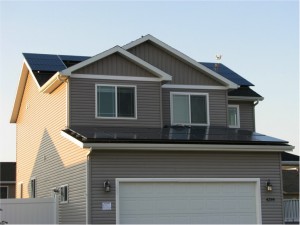
To achieve greater sustainability, Concordia has seriously considered solar energy. After receiving a $550,000 grant from the Margaret A. Cargill Foundation, the president’s sustainability council has taken measures to purchase and install a solar array somewhere on campus.
Possibilities for solar panels include anywhere from having a small display somewhere on campus having to a large array that produces the colleges main source of energy.
“We have the money from the grant now so one way or another we will have a solar array on campus,” Foster said. “It would be even more exciting if we could do something bigger.”
Concordia recently issued a solar audit, where a company evaluated the campus in search of suitable rooftops for solar arrays. The most suitable rooftops on campus were Knutson Campus Center and Olson Forum, which receive the most sunlight per day.
These solar panels have yet to be purchased, but Dr. Kenneth Foster, Concordia’s Sustainability Council chair, hopes Concordia can swing the initial cost. Concordia currently pays six cents per kilowatt, a very low cost compared to the average of about 15 cents per kilowatt.
“Solar energy looks very expensive compared to that price,” Foster said. “Energy costs are so low, and there is not a lot of money laying around.”
The solar panels would save the college money, but with electricity costs so low, it could take a long time to save enough money to pay off the solar installation.
“We wouldn’t break even for about 20 years,” Foster said.
After that point, the solar panels could provide most if not all of Concordia’s energy, depending on the size of the array – energy costs could be nearly free.
In the meantime, Concordia must scrape together enough up-front capital to purchase the panels. The sustainability council wants a large array, so they would need more funds in addition to the grant.
“All options are on the table now,” Foster said. “We just need to wrestle with financial issues still.”
The council has tinkered with the idea of a third-party donor to help pay the initial costs. This means a company or sponsor would buy the solar panels for Concordia, which would give them a major tax break. Concordia would slowly pay the buyer back, making the solar panels cheaper while the third-party company potentially profits.
“Knowing there’s a grant, and if a third party is willing to jump in then I would say I don’t see why not to get solar panels,” said Laura Weikle, one of Concordia’s Eco-Rep members.
Weikle pointed out the cost of not only the panels themselves, but the installation of the panels and the adaptation to the new energy source.
“It’ll be costly in the beginning but better in the long run,” Weikle said. “We need to think ahead. We need to consider what is better for the world not just now, but later. I would hope having solar panels would encourage students to be more sustainable.”
Over the coming months investigations will continue. Financial calculations will be done as well as work on finding a third party donor.
“We will know what we are doing with the solar panel project sometime next year,” Foster said.
Foster hopes at least a portion of the solar array would be visible to pedestrians, as to remind passersby of Concordia’s sustainability mission.
“I think everyone would love to have solar panels,” he said. “If Concordia gets solar panels, it would be interesting to see if other colleges follow.”


Large projects like these should consider the use of new lower cost higher efficiency Hyper X 2 solar panels that produce energy from both sides of the solar panels. This advanced technology has been around for the past 6 years but it was always considered to be far too expensive to install. Now because of new technological advances Hyper X 2 Bifacial solar panels can be purchased at a much lower cost than many standard single sided solar panels.
Instead of boxy looking 1 1/2 to 2 inch thick framed Gen 1 solar panels, these new higher performance Gen 2 solar panels are only 1/4 inch thin and are made with a stronger, see through, glass on glass, frameless, construction that allows sunlight to pass through and reflect off the roof’s surface, thus illuminating the backside of the double sided solar cells, producing additional power.
A mere 10% boost in reflected light can raise this 340 watt solar panel’s output to 374 watts without taking up anymore roof space. New Hyper X 2 solar offers a better PTC to STC ratio “Real World” performance according to the California Energy Commission’s performance rating listings than over 100 of SunPower’s solar panel models.
And they offer a very high 92.88% PTC to STC performance ratio. Hyper X 2 also offers a heat resistant -0.31%/degree C temperature coefficient for better performance in warm/hot climates. And when it comes to aesthetics, nothing even comes close to Hyper X 2’s glass on glass, see through, frameless construction.
With N-type mono-crystalline bifacial cells for double sided power production, up to a 21.5% efficiency rating, superior aesthetics, and a price that outcompetes the solar lease and PPA company’s offerings, very few products on the market compares to Hyper X 2 Solar.